Python Programming - Files & Exceptions
0 likes477 views
Session 7 Python Programming slide series is part of Object-Oriented System Analysing & Designing in CS.QIAU Undergrad.
1 of 32
Downloaded 17 times




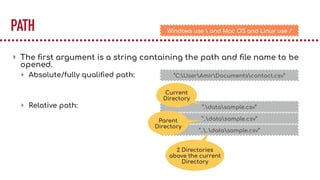







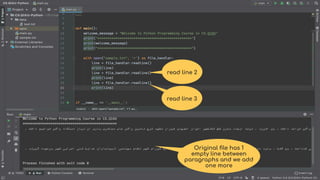





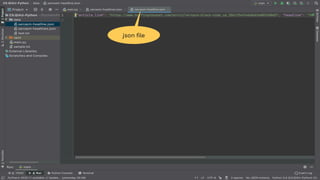
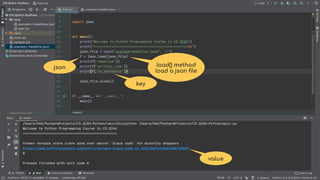
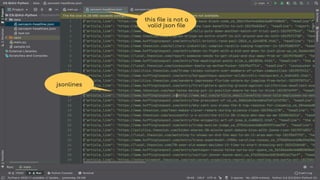



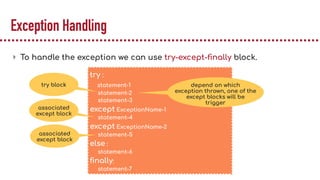

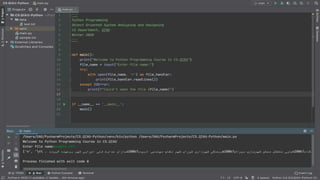

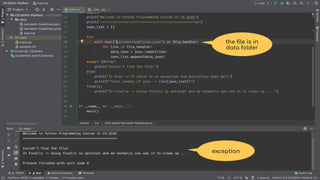
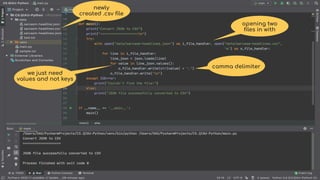


Ad
Recommended
Python programming : Classes objects



Python programming : Classes objectsEmertxe Information Technologies Pvt Ltd A class is a code template for creating objects. Objects have member variables and have behaviour associated with them. In python a class is created by the keyword class.
An object is created using the constructor of the class. This object will then be called the instance of the class.
Python : Data Types



Python : Data TypesEmertxe Information Technologies Pvt Ltd All data values in Python are encapsulated in relevant object classes. Everything in Python is an object and every object has an identity, a type, and a value. Like another object-oriented language such as Java or C++, there are several data types which are built into Python. Extension modules which are written in C, Java, or other languages can define additional types.
To determine a variable's type in Python you can use the type() function. The value of some objects can be changed. Objects whose value can be changed are called mutable and objects whose value is unchangeable (once they are created) are called immutable.
Python - object oriented



Python - object orientedLearnbay Datascience This presentation educates you about objectives of python with example syntax, OOP Terminology, Creating Classes, Creating Instance Objects, Accessing Attributes and Built-In Class Attributes.
Python-Classes.pptx



Python-Classes.pptxKarudaiyar Ganapathy Object-oriented programming (OOP) organizes code around data objects rather than functions. In Python, classes are user-defined templates for objects that contain attributes (data) and methods (functions). When a class is instantiated, an object is created with its own copies of the attributes. Self refers to the object itself and allows methods to access and modify its attributes. Classes in Python allow for code reusability, modularity, and flexibility through encapsulation, inheritance, and polymorphism.
Class, object and inheritance in python



Class, object and inheritance in pythonSantosh Verma The document discusses object-oriented programming concepts in Python, including classes, objects, methods, inheritance, and the built-in __init__ method. Classes are created using the class keyword and contain attributes and methods. Methods must have a self parameter, which refers to the instance of the class. The __init__ method is similar to a constructor and is called when an object is instantiated. Inheritance allows one class to inherit attributes and methods from another class.
List comprehensions



List comprehensionsJordi Gómez The document discusses list comprehensions in Python. List comprehensions provide a concise way to create lists by applying operations to elements in an iterable. They improve readability, compactness, and execution speed compared to traditional loops. However, list comprehensions are not suitable when list elements involve complex data structures or computations.
Python exception handling



Python exception handlingMohammed Sikander Exception handling in Python allows programmers to handle errors and exceptions that occur during runtime. The try/except block handles exceptions, with code in the try block executing normally and code in the except block executing if an exception occurs. Finally blocks ensure code is always executed after a try/except block. Programmers can define custom exceptions and raise exceptions using the raise statement.
PHP - Introduction to Object Oriented Programming with PHP



PHP - Introduction to Object Oriented Programming with PHPVibrant Technologies & Computers This ppt gives information about:
1. OOPs Theory
2. Defining a Class
3. Creating an Object
4. The $this Attribute
5. Creating Constructors
6. Creating Destructors
Decision Structures and Boolean Logic



Decision Structures and Boolean LogicMunazza-Mah-Jabeen This document discusses decision structures and Boolean logic in Python. It covers if, if-else, and if-elif-else statements for conditionally executing code blocks based on Boolean expressions. Boolean expressions use relational operators like ==, >, < to compare values and return True or False. Strings can also be compared. Nested if statements allow conditional checks within other conditional blocks. Proper indentation is important for readability and syntax.
Python File Handling | File Operations in Python | Learn python programming |...



Python File Handling | File Operations in Python | Learn python programming |...Edureka! ** Python Certification Training: https://www.edureka.co/python **
This Edureka PPT on File Handling with Python covers all the important aspects of using files in Python right from the introduction to what fields are, all the way till checking out the major aspects of working with files and using the code-first approach to understand them better.
Python Tutorial Playlist: https://goo.gl/WsBpKe
Blog Series: http://bit.ly/2sqmP4s
Follow us to never miss an update in the future.
Instagram: https://www.instagram.com/edureka_learning/
Facebook: https://www.facebook.com/edurekaIN/
Twitter: https://twitter.com/edurekain
LinkedIn: https://www.linkedin.com/company/edureka
Python OOPs



Python OOPsBinay Kumar Ray This document provides an introduction to object oriented programming in Python. It discusses key OOP concepts like classes, methods, encapsulation, abstraction, inheritance, polymorphism, and more. Each concept is explained in 1-2 paragraphs with examples provided in Python code snippets. The document is presented as a slideshow that is meant to be shared and provide instruction on OOP in Python.
Functions in Python



Functions in PythonKamal Acharya This slide contains detail information regarding the types of functions in python and their implementation
Python programming : Files



Python programming : FilesEmertxe Information Technologies Pvt Ltd The document discusses files in Python. It defines a file as an object that stores data, information, settings or commands used with a computer program. There are two main types of files - text files which store data as strings, and binary files which store data as bytes. The document outlines how to open, read, write, append, close and manipulate files in Python using functions like open(), read(), write(), close() etc. It also discusses pickling and unpickling objects to binary files for serialization. Finally, it covers working with directories and running other programs from Python.
Oop concepts in python



Oop concepts in pythonbaabtra.com - No. 1 supplier of quality freshers This document provides an overview of object-oriented programming concepts in Python including objects, classes, inheritance, polymorphism, and encapsulation. It defines key terms like objects, classes, and methods. It explains how to create classes and objects in Python. It also discusses special methods, modules, and the __name__ variable.
Python lambda functions with filter, map & reduce function



Python lambda functions with filter, map & reduce functionARVIND PANDE Lambda functions allow the creation of small anonymous functions and can be passed as arguments to other functions. The map() function applies a lambda function to each element of a list and returns a new list. The filter() function filters a list based on the return value of a lambda function. The reduce() function iteratively applies a lambda function to consecutive pairs in a list and returns a single value. User-defined functions in Python can perform tasks like converting between temperature scales, finding max/min/average of lists, generating Fibonacci series, reversing strings, summing digits in numbers, and calculating powers using recursion.
Basics of Object Oriented Programming in Python



Basics of Object Oriented Programming in PythonSujith Kumar The document discusses key concepts of object-oriented programming (OOP) including classes, objects, methods, encapsulation, inheritance, and polymorphism. It provides examples of classes in Python and explains OOP principles like defining classes with the class keyword, using self to reference object attributes and methods, and inheriting from base classes. The document also describes operator overloading in Python to allow operators to have different meanings based on the object types.
Operator Overloading In Python



Operator Overloading In PythonSimplilearn This tutorial on Operator Overloading in Python will you learn the various aspects of Operator overloading in Python. The Python tutorial will make you understand the concept of Operator Overloading and will demonstrate how to overload operators in Python with classic examples. You will get to know the concept deeper with a hands-on demo.
Functions and modules in python



Functions and modules in pythonKarin Lagesen The document discusses functions, modules, and how to modularize Python programs. It provides examples of defining functions, using parameters, returning values, and function scope. It also discusses creating modules, importing modules, and the difference between running a Python file as a module versus running it as the main script using the __name__ == "__main__" check. The key points are that functions help break programs into reusable and readable components, modules further help organize code, and the __name__ check allows code to run differently depending on how it is imported or run directly.
Chapter 03 python libraries



Chapter 03 python librariesPraveen M Jigajinni Python modules allow for code reusability and organization. There are three main components of a Python program: libraries/packages, modules, and functions/sub-modules. Modules can be imported using import, from, or from * statements. Namespaces and name resolution determine how names are looked up and associated with objects. Packages are collections of related modules and use an __init__.py file to be recognized as packages by Python.
Python Dictionaries and Sets



Python Dictionaries and SetsNicole Ryan This chapter discusses dictionaries and sets in Python. It covers how to create, manipulate, and iterate over dictionaries and sets. Some key dictionary topics include adding and retrieving key-value pairs, checking for keys, and using dictionary methods. For sets, the chapter discusses set operations like union, intersection, difference and symmetric difference. It also covers serializing objects using the pickle module.
Modules and packages in python



Modules and packages in pythonTMARAGATHAM Modules allow grouping of related functions and code into reusable files. Packages are groups of modules that provide related functionality. There are several ways to import modules and their contents using import and from statements. The document provides examples of creating modules and packages in Python and importing from them.
Python Functions Tutorial | Working With Functions In Python | Python Trainin...



Python Functions Tutorial | Working With Functions In Python | Python Trainin...Edureka! ** Python Certification Training: https://www.edureka.co/python **
This Edureka PPT on Python Functions tutorial covers all the important aspects of functions in Python right from the introduction to what functions are, all the way till checking out the major functions and using the code-first approach to understand them better.
Agenda
Why use Functions?
What are the Functions?
Types of Python Functions
Built-in Functions in Python
User-defined Functions in Python
Python Lambda Function
Conclusion
Python Tutorial Playlist: https://goo.gl/WsBpKe
Blog Series: http://bit.ly/2sqmP4s
Follow us to never miss an update in the future.
Instagram: https://www.instagram.com/edureka_learning/
Facebook: https://www.facebook.com/edurekaIN/
Twitter: https://twitter.com/edurekain
LinkedIn: https://www.linkedin.com/company/edureka
Python Variable Types, List, Tuple, Dictionary



Python Variable Types, List, Tuple, DictionarySoba Arjun METHODS DESCRIPTION
copy() They copy() method returns a shallow copy of the dictionary.
clear() The clear() method removes all items from the dictionary.
pop() Removes and returns an element from a dictionary having the given key.
popitem() Removes the arbitrary key-value pair from the dictionary and returns it as tuple.
get() It is a conventional method to access a value for a key.
dictionary_name.values() returns a list of all the values available in a given dictionary.
str() Produces a printable string representation of a dictionary.
update() Adds dictionary dict2’s key-values pairs to dict
setdefault() Set dict[key]=default if key is not already in dict
keys() Returns list of dictionary dict’s keys
items() Returns a list of dict’s (key, value) tuple pairs
has_key() Returns true if key in dictionary dict, false otherwise
fromkeys() Create a new dictionary with keys from seq and values set to value.
type() Returns the type of the passed variable.
cmp() Compares elements of both dict.
pandas - Python Data Analysis



pandas - Python Data AnalysisAndrew Henshaw This document provides an overview of Python for data analysis using the pandas library. It discusses key pandas concepts like Series and DataFrames for working with one-dimensional and multi-dimensional labeled data structures. It also covers common data analysis tasks in pandas such as data loading, aggregation, grouping, pivoting, filtering, handling time series data, and plotting.
Data types in c++



Data types in c++Venkata.Manish Reddy The document discusses various data types in C++ including built-in, user-defined, and derived types. Structures and unions allow grouping of dissimilar element types. Classes define custom data types that can then be used to create objects. Enumerated types attach numeric values to named constants. Arrays define a collection of elements of the same type in sequence. Functions contain blocks of code to perform tasks. Pointers store memory addresses.
Data types in php



Data types in phpilakkiya This document discusses the different data types in PHP, including integer, floating point, boolean, string, array, object, resource, and null. It provides examples and explanations of each data type. Integer is for whole numbers, floating point for numbers with decimals, boolean for true/false values, string for text values that can be declared with single, double, heredoc, or nowdoc quotes. Array stores multiple values, resource references external functions, and null represents a variable with no value.
Python-03| Data types



Python-03| Data typesMohd Sajjad Data types in Python. Their immutable behavior. Fundamental data types. Table of immutability. tree diagram of data types in python...
File Handling Python



File Handling PythonAkhil Kaushik Files in Python represent sequences of bytes stored on disk for permanent storage. They can be opened in different modes like read, write, append etc using the open() function, which returns a file object. Common file operations include writing, reading, seeking to specific locations, and closing the file. The with statement is recommended for opening and closing files to ensure they are properly closed even if an exception occurs.
Chapter 11



Chapter 11Terry Yoast The document discusses storing and retrieving data from files using streams in Visual Basic. It describes how to declare and instantiate objects, save data to files using StreamWriter, and read data from files using StreamReader. It also covers checking for the end of file, displaying open/save file dialogs, and closing files after reading/writing.
Ad
More Related Content
What's hot (20)
Decision Structures and Boolean Logic



Decision Structures and Boolean LogicMunazza-Mah-Jabeen This document discusses decision structures and Boolean logic in Python. It covers if, if-else, and if-elif-else statements for conditionally executing code blocks based on Boolean expressions. Boolean expressions use relational operators like ==, >, < to compare values and return True or False. Strings can also be compared. Nested if statements allow conditional checks within other conditional blocks. Proper indentation is important for readability and syntax.
Python File Handling | File Operations in Python | Learn python programming |...



Python File Handling | File Operations in Python | Learn python programming |...Edureka! ** Python Certification Training: https://www.edureka.co/python **
This Edureka PPT on File Handling with Python covers all the important aspects of using files in Python right from the introduction to what fields are, all the way till checking out the major aspects of working with files and using the code-first approach to understand them better.
Python Tutorial Playlist: https://goo.gl/WsBpKe
Blog Series: http://bit.ly/2sqmP4s
Follow us to never miss an update in the future.
Instagram: https://www.instagram.com/edureka_learning/
Facebook: https://www.facebook.com/edurekaIN/
Twitter: https://twitter.com/edurekain
LinkedIn: https://www.linkedin.com/company/edureka
Python OOPs



Python OOPsBinay Kumar Ray This document provides an introduction to object oriented programming in Python. It discusses key OOP concepts like classes, methods, encapsulation, abstraction, inheritance, polymorphism, and more. Each concept is explained in 1-2 paragraphs with examples provided in Python code snippets. The document is presented as a slideshow that is meant to be shared and provide instruction on OOP in Python.
Functions in Python



Functions in PythonKamal Acharya This slide contains detail information regarding the types of functions in python and their implementation
Python programming : Files



Python programming : FilesEmertxe Information Technologies Pvt Ltd The document discusses files in Python. It defines a file as an object that stores data, information, settings or commands used with a computer program. There are two main types of files - text files which store data as strings, and binary files which store data as bytes. The document outlines how to open, read, write, append, close and manipulate files in Python using functions like open(), read(), write(), close() etc. It also discusses pickling and unpickling objects to binary files for serialization. Finally, it covers working with directories and running other programs from Python.
Oop concepts in python



Oop concepts in pythonbaabtra.com - No. 1 supplier of quality freshers This document provides an overview of object-oriented programming concepts in Python including objects, classes, inheritance, polymorphism, and encapsulation. It defines key terms like objects, classes, and methods. It explains how to create classes and objects in Python. It also discusses special methods, modules, and the __name__ variable.
Python lambda functions with filter, map & reduce function



Python lambda functions with filter, map & reduce functionARVIND PANDE Lambda functions allow the creation of small anonymous functions and can be passed as arguments to other functions. The map() function applies a lambda function to each element of a list and returns a new list. The filter() function filters a list based on the return value of a lambda function. The reduce() function iteratively applies a lambda function to consecutive pairs in a list and returns a single value. User-defined functions in Python can perform tasks like converting between temperature scales, finding max/min/average of lists, generating Fibonacci series, reversing strings, summing digits in numbers, and calculating powers using recursion.
Basics of Object Oriented Programming in Python



Basics of Object Oriented Programming in PythonSujith Kumar The document discusses key concepts of object-oriented programming (OOP) including classes, objects, methods, encapsulation, inheritance, and polymorphism. It provides examples of classes in Python and explains OOP principles like defining classes with the class keyword, using self to reference object attributes and methods, and inheriting from base classes. The document also describes operator overloading in Python to allow operators to have different meanings based on the object types.
Operator Overloading In Python



Operator Overloading In PythonSimplilearn This tutorial on Operator Overloading in Python will you learn the various aspects of Operator overloading in Python. The Python tutorial will make you understand the concept of Operator Overloading and will demonstrate how to overload operators in Python with classic examples. You will get to know the concept deeper with a hands-on demo.
Functions and modules in python



Functions and modules in pythonKarin Lagesen The document discusses functions, modules, and how to modularize Python programs. It provides examples of defining functions, using parameters, returning values, and function scope. It also discusses creating modules, importing modules, and the difference between running a Python file as a module versus running it as the main script using the __name__ == "__main__" check. The key points are that functions help break programs into reusable and readable components, modules further help organize code, and the __name__ check allows code to run differently depending on how it is imported or run directly.
Chapter 03 python libraries



Chapter 03 python librariesPraveen M Jigajinni Python modules allow for code reusability and organization. There are three main components of a Python program: libraries/packages, modules, and functions/sub-modules. Modules can be imported using import, from, or from * statements. Namespaces and name resolution determine how names are looked up and associated with objects. Packages are collections of related modules and use an __init__.py file to be recognized as packages by Python.
Python Dictionaries and Sets



Python Dictionaries and SetsNicole Ryan This chapter discusses dictionaries and sets in Python. It covers how to create, manipulate, and iterate over dictionaries and sets. Some key dictionary topics include adding and retrieving key-value pairs, checking for keys, and using dictionary methods. For sets, the chapter discusses set operations like union, intersection, difference and symmetric difference. It also covers serializing objects using the pickle module.
Modules and packages in python



Modules and packages in pythonTMARAGATHAM Modules allow grouping of related functions and code into reusable files. Packages are groups of modules that provide related functionality. There are several ways to import modules and their contents using import and from statements. The document provides examples of creating modules and packages in Python and importing from them.
Python Functions Tutorial | Working With Functions In Python | Python Trainin...



Python Functions Tutorial | Working With Functions In Python | Python Trainin...Edureka! ** Python Certification Training: https://www.edureka.co/python **
This Edureka PPT on Python Functions tutorial covers all the important aspects of functions in Python right from the introduction to what functions are, all the way till checking out the major functions and using the code-first approach to understand them better.
Agenda
Why use Functions?
What are the Functions?
Types of Python Functions
Built-in Functions in Python
User-defined Functions in Python
Python Lambda Function
Conclusion
Python Tutorial Playlist: https://goo.gl/WsBpKe
Blog Series: http://bit.ly/2sqmP4s
Follow us to never miss an update in the future.
Instagram: https://www.instagram.com/edureka_learning/
Facebook: https://www.facebook.com/edurekaIN/
Twitter: https://twitter.com/edurekain
LinkedIn: https://www.linkedin.com/company/edureka
Python Variable Types, List, Tuple, Dictionary



Python Variable Types, List, Tuple, DictionarySoba Arjun METHODS DESCRIPTION
copy() They copy() method returns a shallow copy of the dictionary.
clear() The clear() method removes all items from the dictionary.
pop() Removes and returns an element from a dictionary having the given key.
popitem() Removes the arbitrary key-value pair from the dictionary and returns it as tuple.
get() It is a conventional method to access a value for a key.
dictionary_name.values() returns a list of all the values available in a given dictionary.
str() Produces a printable string representation of a dictionary.
update() Adds dictionary dict2’s key-values pairs to dict
setdefault() Set dict[key]=default if key is not already in dict
keys() Returns list of dictionary dict’s keys
items() Returns a list of dict’s (key, value) tuple pairs
has_key() Returns true if key in dictionary dict, false otherwise
fromkeys() Create a new dictionary with keys from seq and values set to value.
type() Returns the type of the passed variable.
cmp() Compares elements of both dict.
pandas - Python Data Analysis



pandas - Python Data AnalysisAndrew Henshaw This document provides an overview of Python for data analysis using the pandas library. It discusses key pandas concepts like Series and DataFrames for working with one-dimensional and multi-dimensional labeled data structures. It also covers common data analysis tasks in pandas such as data loading, aggregation, grouping, pivoting, filtering, handling time series data, and plotting.
Data types in c++



Data types in c++Venkata.Manish Reddy The document discusses various data types in C++ including built-in, user-defined, and derived types. Structures and unions allow grouping of dissimilar element types. Classes define custom data types that can then be used to create objects. Enumerated types attach numeric values to named constants. Arrays define a collection of elements of the same type in sequence. Functions contain blocks of code to perform tasks. Pointers store memory addresses.
Data types in php



Data types in phpilakkiya This document discusses the different data types in PHP, including integer, floating point, boolean, string, array, object, resource, and null. It provides examples and explanations of each data type. Integer is for whole numbers, floating point for numbers with decimals, boolean for true/false values, string for text values that can be declared with single, double, heredoc, or nowdoc quotes. Array stores multiple values, resource references external functions, and null represents a variable with no value.
Python-03| Data types



Python-03| Data typesMohd Sajjad Data types in Python. Their immutable behavior. Fundamental data types. Table of immutability. tree diagram of data types in python...
File Handling Python



File Handling PythonAkhil Kaushik Files in Python represent sequences of bytes stored on disk for permanent storage. They can be opened in different modes like read, write, append etc using the open() function, which returns a file object. Common file operations include writing, reading, seeking to specific locations, and closing the file. The with statement is recommended for opening and closing files to ensure they are properly closed even if an exception occurs.
Similar to Python Programming - Files & Exceptions (20)
Chapter 11



Chapter 11Terry Yoast The document discusses storing and retrieving data from files using streams in Visual Basic. It describes how to declare and instantiate objects, save data to files using StreamWriter, and read data from files using StreamReader. It also covers checking for the end of file, displaying open/save file dialogs, and closing files after reading/writing.
File handling & regular expressions in python programming



File handling & regular expressions in python programmingSrinivas Narasegouda The document discusses file handling and regular expressions in Python programming. It covers opening, reading, and writing files in both text and binary modes. It also describes parsing text files using built-in functions and regular expressions. Regular expressions topics covered include characters, character classes, quantifiers, grouping, capturing, assertions, and flags. The document provides examples of using the re module to search and manipulate strings using regular expression patterns.
File handling4.pdf



File handling4.pdfsulekha24 The document discusses file handling in Python. It begins by explaining the need for files, such as to store data permanently and access it faster. It then covers opening and closing files, different file modes, reading and writing text files, modifying files by replacing strings, and using file attributes and methods like seek, tell, readlines and writelines. The document provides examples to demonstrate basic text file operations in Python.
Module, mixins and file handling in ruby



Module, mixins and file handling in rubyAnanta Lamichhane Modules are wrappers around Ruby code that cannot be instantiated. They are used to bundle logically related objects together and provide namespaces to avoid naming conflicts. Modules can also be used as mixins by including them in classes to add additional functionality. The document provides examples of using modules as namespaces and mixins, and discusses how to load, require, and include modules from separate files. It also covers how the Enumerable and Comparable modules can be included to add common iteration and comparison methods to classes.
Python Lecture 9



Python Lecture 9Inzamam Baig This document discusses fundamentals of programming with files in Python. It covers opening and reading files, line by line processing, writing to files, and using the CSV module. Key points include opening a file returns a file handle, the for loop efficiently reads files line by line, writing requires opening in 'w' mode, and the CSV module supports reading and writing comma separated value files.
Qtp launch



Qtp launchG C Reddy Technologies Ways of Launching Applications in QTP, using SystemUtil.Run, InvokeApplication and using Shell Object
File handling3.pdf



File handling3.pdfnishant874609 The document discusses file handling in Python. It begins by explaining the need for file handling such as storing data permanently and accessing it faster. It then defines what a file is and explains the different types of files - text files and binary files. It discusses the three main steps for file handling in Python - opening the file, processing the file by performing read/write operations, and closing the file. It also describes various file opening modes, methods for reading and writing text files, and modifying or appending content to text files.
File handling



File handlingSwarup Kumar Boro The document discusses various components of C++ used for file handling such as header files, classes, file modes, and functions. It explains the classes ifstream, ofstream, and fstream used to open files in different modes. It also describes functions like open(), close(), get(), getline(), put(), tellg(), seekg(), tellp(), and seekp() and how to detect the end of files with and without using eof().
File handling in Python



File handling in PythonMegha V The document discusses file handling in Python. It explains that a file is used to permanently store data in non-volatile memory. It describes opening, reading, writing, and closing files. It discusses opening files in different modes like read, write, append. It also explains attributes of file objects like name, closed, and mode. The document also covers reading and writing text and binary files, pickle module for serialization, and working with CSV files and the os.path module.
File handling3 (1).pdf uhgipughserigrfiogrehpiuhnfi;reuge



File handling3 (1).pdf uhgipughserigrfiogrehpiuhnfi;reugevsol7206 ginoegnareo;nbrawo;ignhwbouhnfo;gklnvsfoirughnifkirhgnbfklnirghisfbksior'bhjinsorkflbinejtrhobfknaehiorhnbfklraioen
Python files / directories part15



Python files / directories part15Vishal Dutt The document discusses file handling in Python. It explains that the open() function is key for working with files in Python and takes a filename and mode as parameters. It describes different modes for opening files, including 'r' for reading, 'a' for appending, and 'w' for writing. The document also covers getting file attributes after opening and the close() method for closing files.
FIle Handling and dictionaries.pptx



FIle Handling and dictionaries.pptxAshwini Raut This document provides information on file handling and dictionaries in Python. It discusses file paths, opening and closing files, reading from and writing to files. It also covers creating, accessing, adding, updating and deleting elements in dictionaries. Finally, it discusses directory methods like getcwd(), chdir(), listdir(), mkdir(), rmdir() and rename() for working with directories in Python.
Cs1123 10 file operations



Cs1123 10 file operationsTAlha MAlik This document discusses file operations in C++. It defines what a file is and describes basic file operations like opening, writing, reading, and closing files. It explains how to set up a C++ program for file input/output by including the fstream header. Different stream objects like ifstream, ofstream, and fstream are used to represent input/output from files. The document also covers opening files, checking for open errors, writing and reading data from files using insertion and extraction operators, formatting file output, detecting the end of a file, and using getline() and put() functions for character I/O.
chapter-12-data-file-handling.pdf



chapter-12-data-file-handling.pdfstudy material This document discusses file handling in C++. It explains that a file is a collection of related data stored on disk. C++ uses streams for file input/output, with input/output streams represented by ifstream and ofstream classes. Files must be opened before reading or writing, which can be done through constructors or the open() member function. Text files store data as characters while binary files store raw data. Common operations include reading and writing single characters or whole lines from text files, and reading/writing blocks of raw data from binary files.
Ad
Recently uploaded (20)
WinRAR Crack for Windows (100% Working 2025)



WinRAR Crack for Windows (100% Working 2025)sh607827 copy and past on google ➤ ➤➤ https://hdlicense.org/ddl/
WinRAR Crack Free Download is a powerful archive manager that provides full support for RAR and ZIP archives and decompresses CAB, ARJ, LZH, TAR, GZ, ACE, UUE, .
Innovative Approaches to Software Dev no good at all



Innovative Approaches to Software Dev no good at allayeshakanwal75 Innovative Approaches to Software Dev no good at all
Get & Download Wondershare Filmora Crack Latest [2025]![Get & Download Wondershare Filmora Crack Latest [2025]](https://cdn.slidesharecdn.com/ss_thumbnails/revolutionizingresidentialwi-fi-250422112639-60fb726f-250429170801-59e1b240-thumbnail.jpg?width=560&fit=bounds)
![Get & Download Wondershare Filmora Crack Latest [2025]](https://cdn.slidesharecdn.com/ss_thumbnails/revolutionizingresidentialwi-fi-250422112639-60fb726f-250429170801-59e1b240-thumbnail.jpg?width=560&fit=bounds)
![Get & Download Wondershare Filmora Crack Latest [2025]](https://cdn.slidesharecdn.com/ss_thumbnails/revolutionizingresidentialwi-fi-250422112639-60fb726f-250429170801-59e1b240-thumbnail.jpg?width=560&fit=bounds)
![Get & Download Wondershare Filmora Crack Latest [2025]](https://cdn.slidesharecdn.com/ss_thumbnails/revolutionizingresidentialwi-fi-250422112639-60fb726f-250429170801-59e1b240-thumbnail.jpg?width=560&fit=bounds)
Get & Download Wondershare Filmora Crack Latest [2025]saniaaftab72555 Copy & Past Link 👉👉
https://dr-up-community.info/
Wondershare Filmora is a video editing software and app designed for both beginners and experienced users. It's known for its user-friendly interface, drag-and-drop functionality, and a wide range of tools and features for creating and editing videos. Filmora is available on Windows, macOS, iOS (iPhone/iPad), and Android platforms.
Interactive odoo dashboards for sales, CRM , Inventory, Invoice, Purchase, Pr...



Interactive odoo dashboards for sales, CRM , Inventory, Invoice, Purchase, Pr...AxisTechnolabs Interactive Odoo Dashboard for various business needs can provide users with dynamic, visually appealing dashboards tailored to their specific requirements. such a module that could support multiple dashboards for different aspects of a business
✅Visit And Buy Now : https://bit.ly/3VojWza
✅This Interactive Odoo dashboard module allow user to create their own odoo interactive dashboards for various purpose.
App download now :
Odoo 18 : https://bit.ly/3VojWza
Odoo 17 : https://bit.ly/4h9Z47G
Odoo 16 : https://bit.ly/3FJTEA4
Odoo 15 : https://bit.ly/3W7tsEB
Odoo 14 : https://bit.ly/3BqZDHg
Odoo 13 : https://bit.ly/3uNMF2t
Try Our website appointment booking odoo app : https://bit.ly/3SvNvgU
👉Want a Demo ?📧 [email protected]
➡️Contact us for Odoo ERP Set up : 091066 49361
👉Explore more apps: https://bit.ly/3oFIOCF
👉Want to know more : 🌐 https://www.axistechnolabs.com/
#odoo #odoo18 #odoo17 #odoo16 #odoo15 #odooapps #dashboards #dashboardsoftware #odooerp #odooimplementation #odoodashboardapp #bestodoodashboard #dashboardapp #odoodashboard #dashboardmodule #interactivedashboard #bestdashboard #dashboard #odootag #odooservices #odoonewfeatures #newappfeatures #odoodashboardapp #dynamicdashboard #odooapp #odooappstore #TopOdooApps #odooapp #odooexperience #odoodevelopment #businessdashboard #allinonedashboard #odooproducts
The Significance of Hardware in Information Systems.pdf



The Significance of Hardware in Information Systems.pdfdrewplanas10 The Significance of Hardware in Information Systems: The Types Of Hardware and What They Do
Why Orangescrum Is a Game Changer for Construction Companies in 2025



Why Orangescrum Is a Game Changer for Construction Companies in 2025Orangescrum Orangescrum revolutionizes construction project management in 2025 with real-time collaboration, resource planning, task tracking, and workflow automation, boosting efficiency, transparency, and on-time project delivery.
DVDFab Crack FREE Download Latest Version 2025

DVDFab Crack FREE Download Latest Version 2025younisnoman75 ⭕️➡️ FOR DOWNLOAD LINK : http://drfiles.net/ ⬅️⭕️
DVDFab is a multimedia software suite primarily focused on DVD and Blu-ray disc processing. It offers tools for copying, ripping, creating, and editing DVDs and Blu-rays, as well as features for downloading videos from streaming sites. It also provides solutions for playing locally stored video files and converting audio and video formats.
Here's a more detailed look at DVDFab's offerings:
DVD Copy:
DVDFab offers software for copying and cloning DVDs, including removing copy protections and creating backups.
DVD Ripping:
This allows users to rip DVDs to various video and audio formats for playback on different devices, while maintaining the original quality.
Blu-ray Copy:
DVDFab provides tools for copying and cloning Blu-ray discs, including removing Cinavia protection and creating lossless backups.
4K UHD Copy:
DVDFab is known for its 4K Ultra HD Blu-ray copy software, allowing users to copy these discs to regular BD-50/25 discs or save them as 1:1 lossless ISO files.
DVD Creator:
This tool allows users to create DVDs from various video and audio formats, with features like GPU acceleration for faster burning.
Video Editing:
DVDFab includes a video editing tool for tasks like cropping, trimming, adding watermarks, external subtitles, and adjusting brightness.
Video Player:
A free video player that supports a wide range of video and audio formats.
All-In-One:
DVDFab offers a bundled software package, DVDFab All-In-One, that includes various tools for handling DVD and Blu-ray processing.
PDF Reader Pro Crack Latest Version FREE Download 2025



PDF Reader Pro Crack Latest Version FREE Download 2025mu394968 🌍📱👉COPY LINK & PASTE ON GOOGLE https://dr-kain-geera.info/👈🌍
PDF Reader Pro is a software application, often referred to as an AI-powered PDF editor and converter, designed for viewing, editing, annotating, and managing PDF files. It supports various PDF functionalities like merging, splitting, converting, and protecting PDFs. Additionally, it can handle tasks such as creating fillable forms, adding digital signatures, and performing optical character recognition (OCR).
What Do Contribution Guidelines Say About Software Testing? (MSR 2025)



What Do Contribution Guidelines Say About Software Testing? (MSR 2025)Andre Hora Software testing plays a crucial role in the contribution process of open-source projects. For example, contributions introducing new features are expected to include tests, and contributions with tests are more likely to be accepted. Although most real-world projects require contributors to write tests, the specific testing practices communicated to contributors remain unclear. In this paper, we present an empirical study to understand better how software testing is approached in contribution guidelines. We analyze the guidelines of 200 Python and JavaScript open-source software projects. We find that 78% of the projects include some form of test documentation for contributors. Test documentation is located in multiple sources, including CONTRIBUTING files (58%), external documentation (24%), and README files (8%). Furthermore, test documentation commonly explains how to run tests (83.5%), but less often provides guidance on how to write tests (37%). It frequently covers unit tests (71%), but rarely addresses integration (20.5%) and end-to-end tests (15.5%). Other key testing aspects are also less frequently discussed: test coverage (25.5%) and mocking (9.5%). We conclude by discussing implications and future research.
Expand your AI adoption with AgentExchange



Expand your AI adoption with AgentExchangeFexle Services Pvt. Ltd. AgentExchange is Salesforce’s latest innovation, expanding upon the foundation of AppExchange by offering a centralized marketplace for AI-powered digital labor. Designed for Agentblazers, developers, and Salesforce admins, this platform enables the rapid development and deployment of AI agents across industries.
Email: [email protected]
Phone: +1(630) 349 2411
Website: https://www.fexle.com/blogs/agentexchange-an-ultimate-guide-for-salesforce-consultants-businesses/?utm_source=slideshare&utm_medium=pptNg
Microsoft AI Nonprofit Use Cases and Live Demo_2025.04.30.pdf



Microsoft AI Nonprofit Use Cases and Live Demo_2025.04.30.pdfTechSoup In this webinar we will dive into the essentials of generative AI, address key AI concerns, and demonstrate how nonprofits can benefit from using Microsoft’s AI assistant, Copilot, to achieve their goals.
This event series to help nonprofits obtain Copilot skills is made possible by generous support from Microsoft.
What You’ll Learn in Part 2:
Explore real-world nonprofit use cases and success stories.
Participate in live demonstrations and a hands-on activity to see how you can use Microsoft 365 Copilot in your own work!
Adobe Marketo Engage Champion Deep Dive - SFDC CRM Synch V2 & Usage Dashboards



Adobe Marketo Engage Champion Deep Dive - SFDC CRM Synch V2 & Usage DashboardsBradBedford3 Join Ajay Sarpal and Miray Vu to learn about key Marketo Engage enhancements. Discover improved in-app Salesforce CRM connector statistics for easy monitoring of sync health and throughput. Explore new Salesforce CRM Synch Dashboards providing up-to-date insights into weekly activity usage, thresholds, and limits with drill-down capabilities. Learn about proactive notifications for both Salesforce CRM sync and product usage overages. Get an update on improved Salesforce CRM synch scale and reliability coming in Q2 2025.
Key Takeaways:
Improved Salesforce CRM User Experience: Learn how self-service visibility enhances satisfaction.
Utilize Salesforce CRM Synch Dashboards: Explore real-time weekly activity data.
Monitor Performance Against Limits: See threshold limits for each product level.
Get Usage Over-Limit Alerts: Receive notifications for exceeding thresholds.
Learn About Improved Salesforce CRM Scale: Understand upcoming cloud-based incremental sync.
🌱 Green Grafana 🌱 Essentials_ Data, Visualizations and Plugins.pdf



🌱 Green Grafana 🌱 Essentials_ Data, Visualizations and Plugins.pdfImma Valls Bernaus eady to harness the power of Grafana for your HackUPC project? This session provides a rapid introduction to the core concepts you need to get started. We'll cover Grafana fundamentals and guide you through the initial steps of building both compelling dashboards and your very first Grafana app. Equip yourself with the essential tools to visualize your data and bring your innovative ideas to life!
Apple Logic Pro X Crack FRESH Version 2025



Apple Logic Pro X Crack FRESH Version 2025fs4635986 🌍📱👉COPY LINK & PASTE ON GOOGLE http://drfiles.net/ 👈🌍
Logic Pro X is a professional digital audio workstation (DAW) software for macOS, developed by Apple. It's a comprehensive tool for music creation, offering features for songwriting, beat making, editing, and mixing. Logic Pro X provides a wide range of instruments, effects, loops, and samples, enabling users to create a variety of musical styles.
Here's a more detailed breakdown:
Digital Audio Workstation (DAW):
Logic Pro X allows users to record, edit, and mix audio and MIDI tracks, making it a central hub for music production.
MIDI Sequencing:
It supports MIDI sequencing, enabling users to record and manipulate MIDI performances, including manipulating parameters like note velocity, timing, and dynamics.
Software Instruments:
Logic Pro X comes with a vast collection of software instruments, including synthesizers, samplers, and virtual instruments, allowing users to create a wide variety of sounds.
Audio Effects:
It offers a wide range of audio effects, such as reverbs, delays, EQs, compressors, and distortion, enabling users to shape and polish their mixes.
Recording Facilities:
Logic Pro X provides various recording facilities, allowing users to record vocals, instruments, and other audio sources.
Mixing and Mastering:
It offers tools for mixing and mastering, allowing users to refine their mixes and prepare them for release.
Integration with Apple Ecosystem:
Logic Pro X integrates well with other Apple products, such as GarageBand, allowing for seamless project transfer and collaboration.
Logic Remote:
It supports remote control via iPad or iPhone, enabling users to manipulate instruments and control mixing functions from another device.
Revolutionizing Residential Wi-Fi PPT.pptx



Revolutionizing Residential Wi-Fi PPT.pptxnidhisingh691197 Discover why Wi-Fi 7 is set to transform wireless networking and how Router Architects is leading the way with next-gen router designs built for speed, reliability, and innovation.
Implementing promises with typescripts, step by step



Implementing promises with typescripts, step by stepRan Wahle Implementing promises with typescripts, step by step.
This slides were presented at Negev Web Development meetup
Scaling GraphRAG: Efficient Knowledge Retrieval for Enterprise AI



Scaling GraphRAG: Efficient Knowledge Retrieval for Enterprise AIdanshalev If we were building a GenAI stack today, we'd start with one question: Can your retrieval system handle multi-hop logic?
Trick question, b/c most can’t. They treat retrieval as nearest-neighbor search.
Today, we discussed scaling #GraphRAG at AWS DevOps Day, and the takeaway is clear: VectorRAG is naive, lacks domain awareness, and can’t handle full dataset retrieval.
GraphRAG builds a knowledge graph from source documents, allowing for a deeper understanding of the data + higher accuracy.
Best Practices for Collaborating with 3D Artists in Mobile Game Development



Best Practices for Collaborating with 3D Artists in Mobile Game DevelopmentJuego Studios Discover effective strategies for working with 3D artists on mobile game projects. Learn how top mobile game development companies streamline collaboration with 3D artists in Dubai for high-quality, optimized game assets.
Creating Automated Tests with AI - Cory House - Applitools.pdf



Creating Automated Tests with AI - Cory House - Applitools.pdfApplitools In this fast-paced, example-driven session, Cory House shows how today’s AI tools make it easier than ever to create comprehensive automated tests. Full recording at https://applitools.info/5wv
See practical workflows using GitHub Copilot, ChatGPT, and Applitools Autonomous to generate and iterate on tests—even without a formal requirements doc.
Who Watches the Watchmen (SciFiDevCon 2025)



Who Watches the Watchmen (SciFiDevCon 2025)Allon Mureinik Tests, especially unit tests, are the developers’ superheroes. They allow us to mess around with our code and keep us safe.
We often trust them with the safety of our codebase, but how do we know that we should? How do we know that this trust is well-deserved?
Enter mutation testing – by intentionally injecting harmful mutations into our code and seeing if they are caught by the tests, we can evaluate the quality of the safety net they provide. By watching the watchmen, we can make sure our tests really protect us, and we aren’t just green-washing our IDEs to a false sense of security.
Talk from SciFiDevCon 2025
https://www.scifidevcon.com/courses/2025-scifidevcon/contents/680efa43ae4f5
Ad
Python Programming - Files & Exceptions
- 1. CS.QIAU - Winter 2020 PYTHONFiles & Exceptions- Session 7 Omid AmirGhiasvand Programming
- 2. File ▸ A file is a common storage unit in a computer. ▸ programs can read from a file or write into a file. ▸ Serious program use file or database to save state. ▸ File Extension ▸ determine which program will be associated with the file. ▸ .docx or .txt or .csv or .tsv or .json ▸ .mp3 or .mkv ▸ .exe or .bin or .dmg or .tar.gz ▸ Type of file supported by Python: ▸ Text file ▸ Binary file
- 3. Creating or Opening Text File file_handler = open(file_name, mode) File handler object Built-in function
- 4. File Handler Object ▸ The open() function return a file handler object for the file name. ▸ The first argument is a string containing the path and file name to be opened. ▸ The second argument is also a string describing the way in which the file will be used. Access Mode
- 5. PATH ▸ The first argument is a string containing the path and file name to be opened. ▸ Absolute/fully qualified path: ▸ Relative path: “C:UserAmirDocumentscontact.csv” “.datasample.csv” “..datasample.csv” “....datasample.csv” Current Directory Parent Directory 2 Directories above the current Directory Windows use and Mac OS and Linux use /
- 6. Access Mode ▸ The access mode argument is optional. ▸ ‘r’ will be used if omitted. ▸ Useful Access Modes Mode Description ‘r’ Opens the file in read only mode. ‘w’ Opens the file for writing. If the file already exists then it will get overwritten. If the file does’t exist it creates a new file ‘a’ Opens the file for appending data at the end of the file automatically. If the file does’t exist it creates a new file ‘r+’ Opens the file for both reading and writing. ‘w+’ Opens the file for reading and writing. If the file already exists then it will get overwritten. If the file does’t exist it creates a new file ‘a+’ Opens the file for reading and appending. If a file already exists, the data is appended. If the file does’t exist it creates a new file. ‘x’ Creates a new file. If the file already exists, the operation fails
- 7. ▸ Opening files consume system resources. ▸ To save resource it is important to close the file once processing is completed. ▸ If you do not explicitly close a file, Python’s garbage collector will eventually destroy the object and close the opened file for you, but the file may have stayed open for a while. Closing the File file_handler.close() Memory Leak
- 8. sample.txt relative path current folder Access mode read 1 line and print it
- 9. test.txt in data folder relative path in data folder
- 10. With Statement To Open and Close Files with open(file_name, mode) as file_handler : statement-1 statement-2 statement-3 Keyword Programmer DefinedKeyword We don’t have to close the file manually. You can use the file in this block.
- 11. ▸ File handler methods Working With File Method Syntax Description read() file_handler.read() used to read the contents of a file readline() file_handler.readline() used to read a single line in file. readlines() file_handler.readlines() used to read all the lines of a file as list items. write() file_handler.write() will write the contents of the string to the file. Add n to add newline writelines() file_handler.writelines() will write a sequence of strings to the file. tell() file_handler.tell() returns an integer giving the file handler’s current position within the file seek() file_handler.seek(offset) is used to change the file handler’s position.
- 12. read line 1
- 13. read line 2 read line 3 Original file has 1 empty line between paragraphs and we add one more
- 14. remove the extra new line
- 16. split() method split the text into a list separated by dot 2 dimensionals list It’s one item - A sentence dot delimiter It’s a list - list of sentences remove white space from beginning and end of “line”
- 17. ▸ Lightweight text-based data-interchange. Commonly used for transmitting data in web applications. ▸ http/https protocol JavaScript Object Notation - JSON Client Server http request http response Client/Server Architecture
- 18. ▸ Key-value pair ▸ value data type : string, object, number, boolean and list JSON Format { "article_link": “https://www.huffingtonpost.com/entry/versace-black-code_us_5861fbefe4b0de3a08f600d5", “headline": "former versace store clerk sues over secret 'black code' for minority shoppers", "is_sarcastic": 0 } key value
- 19. json file
- 20. key json value load() method load a json file
- 21. jsonlines this file is not a valid json file
- 22. here each line is a string
- 23. Total number of json object loads() method load a string line that is a json in nature add json into a list
- 24. ▸ There are at least two distinguishable kinds of errors ▸ Syntax Errors ▸ Exceptions ▸ Even if a statement or expression is syntactically correct, it may cause an error when an attempt is made to execute it. An exception is an unwanted event that interrupts the normal flow of the program. ▸ User Defined ▸ Built-in ▸ Exception Handling ▸ Handling of exception ensures that the flow of the program does not get interrupted when an exception occurs which is done by trapping run-time errors. Exception Error in Run-time
- 25. ▸ To handle the exception we can use try-except-finally block. Exception Handling try : statement-1 statement-2 statement-3 except ExceptionName-1 statement-4 except ExceptionName-2 statement-5 else : statement-6 finally: statement-7 depend on which exception thrown, one of the except blocks will be trigger associated except block associated except block try block
- 28. open jsonlines file load string line as a json finally block will execute in all cases else block execute when no exception thrown No exception
- 29. exception the file is in data folder
- 30. newly created .csv file camma delimiter opening two files in with we just need values and not keys
- 31. read csv file each line is a list each line is a list import csv module
- 32. “ The Way You Do One Thing Is the Way You Do Everything”






